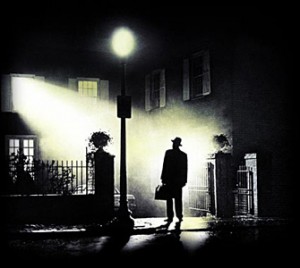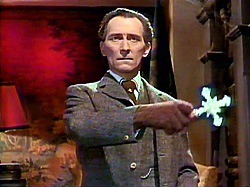 As regular readers of TheoFantastique are aware, some of the facets of the fantastic genres discussed on this site are religion and spirituality. A while back I came across an article by Bryan Stone of the Boston University School of Theology that touched on this topic titled “The Sanctification of Fear: Images of the Religious in Horror Films” from The Journal of Religion and Film Vol. 5, no.2 (October 2001). The abstract for this article reads as follows:
As regular readers of TheoFantastique are aware, some of the facets of the fantastic genres discussed on this site are religion and spirituality. A while back I came across an article by Bryan Stone of the Boston University School of Theology that touched on this topic titled “The Sanctification of Fear: Images of the Religious in Horror Films” from The Journal of Religion and Film Vol. 5, no.2 (October 2001). The abstract for this article reads as follows:
“Horror film functions both as a threat and a catharsis by confronting us with our fear of death, the supernatural, the unknown and irrational, ”the other’ in general, a loss of identity, and forces beyond our control. Over the last century, religious symbols and themes have played a prominent and persistent role in the on-screen construction of this confrontation. That role is, at the same time, ambiguous insofar as religious iconography has become unhinged from a compelling moral vision and reduced to mere conventions that produce a quasi-religious quality to horror that lacks the symbolic power required to engage us at the deepest level of our being. Although religious symbols in horror films are conventional in their frequent use, they may have lost all connection to deeper human questions.”
Dr. Stone was able to clear his schedule recently to answer a few questions related to this interesting article.
TheoFantastique: Thank you for your willingness to discuss your article, and for it’s interesting subject matter. As you begin the piece you discuss horror films and their tendency to cause friction if not repulsion with religious sensibilities, and they you go on to point out that even so there is significant overlap between horror and religious concerns. Given this overlap, something recognized and explored on TheoFantastique regularly, why do you think religious, and sometimes irreligious people, feel that horror and religious sensibilities, particularly in the form of conservative Christianity in America, are difficult if not impossible to bring together?
Bryan Stone: This is an interesting question and there are likely many reasons for it. Growing up around conservative Christians, I know that there is very little room for metaphysical speculation of the sort that imagines supernatural creatures that aren’t specifically mentioned in the Bible. But horror films often grant an independence to evil or explore evil with such imagination and emotional intensity that to watch a horror film is to be led into visceral ‘experiences’ of evil. Christians generally are not supposed to dabble with the occult, the Satanic, demonic, etc., but watching horror films can certainly be looked on as a form of that. All that said, however, conservative Christianity has, in fact, produced its own versions of horror films. Back in the 1970’s, films began to appear that offered portrayals of end-time scenarios, most notably A Thief in the Night (1972), with the tag line “. . . and there will be no place to hide.” The film’s title comes from a description of Christ’s return recorded in 1 Thessalonians 5, and the film tells the story of a young woman who wakes up one morning only to find that her husband and millions of others throughout the world have disappeared. They have been “raptured,” leaving her and others similarly left behind to live through the last days of the planet under the control of the Antichrist. The frightening film was shown widely by Protestant groups at churches, rallies, and youth camps in the service of evangelistic efforts, the intent of which was clearly to scare the viewers toward conversion. The film was followed by three sequels: A Distant Thunder (1978), Image of the Beast (1980), and The Prodigal Planet (1983). The “end-times” Christian film genre (which I’m arguing is very much a horror sub-genre) would resurface in 2000 with Left Behind: The Movie, a film adaptation of the highly successful Left Behindseries of novels written by Tim LaHaye and Jerry B. Jenkins beginning in 1995. Here again, a conservative, dispensationalistinterest in the second coming and a highly imaginative interpretation of biblical prophecy motivates the horrific story of what happens when the true, secret church of Christ is removed from the planet. Lastly, how about Mel Gibson’s The Passion of the Christ? Some people have called this “torture porn,” like the Saw or Hostel series, and I agree. It is a kind of conservative Christian horror film where the body is ravaged on screen and evil lurks everywhere.
TheoFantastique: You wrote your article in 2001, and at that time stated that while there has been an increase in religion and film studies, but this has not led to increased consideration of horror and religion in film. With the publication of books like Douglas Cowan’s Sacred Terror (Baylor University Press, 2008), do you think this might be changing or is the religious dimension of horror still largely ignored in academic study?
Bryan Stone: More scholarly work is indeed being done on this topic and Cowan’s book is a good example. I also see the interest increasing at conferences and among my students. Still, however, horror as a genre, receives scant attention among those who do work on religion and film.
TheoFantastique: Rudolph Otto’s discussion of mysterium tremendum et fascinans, the simultaneous fascination and repulsion in regards to our experience of the holy, which can be applied to similar experiences with horror, is a concept which I find intriguing and filled with possibilities. You mention this in your article and I’d like to ask you to tease this out for the reader if you could.
Bryan Stone: In our time God has often been reduced to the status of a private “buddy”, or a cosmic “pal.” But classically and in most religions there is a long history of understanding God as fear- and awe-inspiring, or even as terrible, all-consuming, and devouring. The arena of the sacred, then, is not the arena of warm fuzzies; rather, as the Hebrew prophet Isaiah says in the temple upon encountering the deity, “Woe is me!” Otto’s concept of the holy is of a transcendent encounter that both draws and lures us to itself and yet shocks, frightens, and reduces us to absolute dependence because of its majesty and wholly “Otherness.” There are real similarities, I think, between the classical encounter with the Holy and what’s going on in many horror films.
 TheoFantastique: You mention that “religious iconography virtually disappears in psychotic ‘slasher’ films where monsters with ordinary names like ‘Jason, Freddie, or Michael’ belong to an extraordinary and even alien world where traditional conventions of sin and morality, good and evil, do not even come into play.” How did we arrive at this apparently nihilistic context for much of contemporary American horror, particularly in what you call psychological horror?
TheoFantastique: You mention that “religious iconography virtually disappears in psychotic ‘slasher’ films where monsters with ordinary names like ‘Jason, Freddie, or Michael’ belong to an extraordinary and even alien world where traditional conventions of sin and morality, good and evil, do not even come into play.” How did we arrive at this apparently nihilistic context for much of contemporary American horror, particularly in what you call psychological horror?
Bryan Stone: It seems to me that once you unhinge questions of good and evil from the traditional metaphysical and religious coordinates in which they were originally framed for Western, Christian cultures and then relocate those questions within a secular, psychological framework that rejects or simply has no need of those traditional coordinates, you find yourself with a whole new kind of horror film. A new iconography, a new set of stock characters, and a new range of story lines begin developing. Of course, the secular is not merely the absence of the religious, as though one had merely stripped away that which was superfluous (as John Milbank has argued so well in Theology and Social Theory). It is itself a constructed account of the way things are, a rival theology, and can be rejected by those who find its account unsatisfying, nihilistic, or implausibly fantastic (think for example of Freudian or Marxist reductionisms that offer less imaginative surplus for postmodern Westerners than they did 40 years ago. As I note in my article, the contemporary turn to the body is a good example of this rejection of wholly psychological coordinates for thematizing good and evil.
 TheoFantastique: In your discussion of body horror you mention death that used to be informed by a “wider humanistic vision and the Judeo-Christian coordinates from which that vision arose,” but now “[h]orror in the last century parallels this repression and eroticisation of, and inevitable fascination with, death.” How has this contributed to our ongoing fascination with the zombie as perhaps the leading horror icon in film, television, videogames, and literature?
TheoFantastique: In your discussion of body horror you mention death that used to be informed by a “wider humanistic vision and the Judeo-Christian coordinates from which that vision arose,” but now “[h]orror in the last century parallels this repression and eroticisation of, and inevitable fascination with, death.” How has this contributed to our ongoing fascination with the zombie as perhaps the leading horror icon in film, television, videogames, and literature?
Bryan Stone: Interesting isn’t it?!! Horror films have always featured characters that won’t die (ghosts, vampires, etc.). But the Zombie is what you get when the body is ravaged by death, yet in the form of a being that won’t die. Ghosts have no bodies and vampires are beautiful creatures. The Zombie is an “in-your-face” body that just won’t die. Your suggestion is provocative and I want to give this some more thought!
TheoFantastique: With the marginalization of traditional and institutionalized forms of religion in Western culture in the 21st century how has the appropriation of religious symbolism changed in horror films?
Bryan Stone: Religious images, symbols, practices, stories, and characters are still present in horror film, but increasingly present eclectically or in a syncretistic fashion. Ours is a time when religious identity is less and less assumed or inherited in the West, but rather self-consciously and creatively constructed from among the world’s organized religions, pop psychology, and the values of consumer capitalism. Religious symbols, characters, and stories, then, are often appropriated in film as superficial signifiers disconnected from the faith traditions that gave rise to them but still useful in connecting with the aesthetic expectations of viewers.
TheoFantastique: Bryan, thank you again for your article, and your willingness to discuss this further here.





2 Responses to “Bryan Stone: Changing Religious Imagery in Horror”